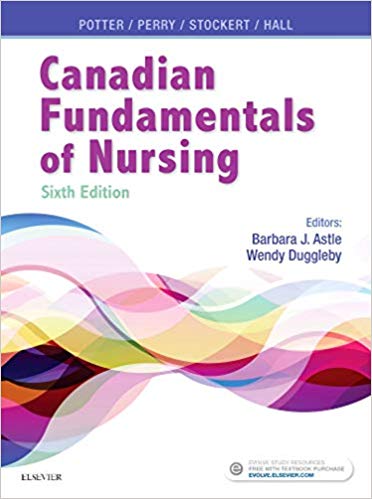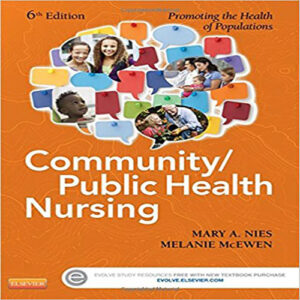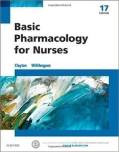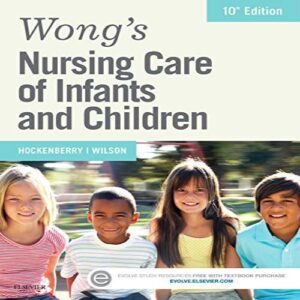Test Bank for Canadian Fundamentals of Nursing 6th Edition By Potter
Chapter 01: Health and Wellness
MULTIPLE CHOICE
1. The nurse is using the population health promotion model to develop actions for improving
health. After asking, “On what should we take action?”; “How should we take action?”; and
“Why should we take action?” the nurse will ask which of the following questions?
a. “With whom should we act?”
b. “When should we take action?”
c. “Which government should take action?”
d. “Where should we first act?”
ANS: A
The next question to ask when using the population health model approach is “With whom
should we act?” The other choices are not questions included in this model.
DIF: Apply REF: 13, Figure 1-5
OBJ: Contrast distinguishing features of health promotion and disease prevention.
TOP: Implementation MSC: CPNRE: Foundations of Practice
2. The principle “Health promotion is multisectoral” means which of the following?
a. Relationships between individual, social, and environmental factors must be
recognized.
b. Physical, mental, social, ecological, cultural, and spiritual aspects of health must
be recognized.
c. In order to change unhealthy living and working conditions, areas other than health
must also be involved.
d. Health promotion involves the use of knowledge from disciplines such as social,
economic, political, environmental, medical, and nursing sciences, as well as from
first-hand experience.
ANS: C
The statement “Health promotion is multisectoral” is the principle explained by the necessity
to involve areas other than health in order to change unhealthy living and working conditions.
DIF: Understand REF: 11
OBJ: Contrast distinguishing features of health promotion and disease prevention.
TOP: Planning MSC: CPNRE: Foundations of Practice
3. According to the World Health Organization, what is the best description of “health”?
a. simply the absence of disease.
b. Involving the total person and environment.
c. Strictly personal in nature.
d. Status of the pathological state.
ANS: B
The WHO defines health as “…the extent to which an individual or group is able, on the one hand, to realize aspirations and satisfy needs; and, on the other hand, to change or cope with the environment. Health is, therefore, seen as a resource for everyday life, not the objective of
living; it is a positive concept emphasizing social and personal resources, as well as physical
capacities.” Nurses’ attitudes toward health and illness should account for the total person, as well as the environment in which the person lives. People free of disease are not equally healthy. Views of health have broadened to include mental, social, and spiritual well-being, as
well as a focus on health at family and community levels. Conditions of life, rather than pathological states, are what determine health.
DIF: Knowledge REF: 2
OBJ: Discuss ways that definitions of health have been conceptualized.
TOP: Evaluate MSC: CPNRE: Foundations of Practice
4. What priority strategy for health promotion in Canada is optional but seen as important to incorporate in nursing education curricula?
a. Knowledge of disease prevention.
b. Strategies for health promotion.
c. Policy advocacy.
d. Concepts of determinants of health.
ANS: C
Increasingly, policy advocacy is incorporated into nursing role statements and nursing education curricula. Nurses should think about policies that have contributed to health
problems, policies that would help to alleviate health problems, and how nursing champions
public policies. Disease prevention is an integral part of nursing curricula. Health promotion is
a fundamental part of nursing curricula.
DIF: Understand REF: 11 | 12
OBJ: Analyze how the nature and scope of nursing practice are influenced by different
conceptualizations of health and health determinants. TOP: Planning
MSC: CPNRE: Foundations of Practice
5. Which of the following is a prerequisite for health, as identified by the Ottawa Charter for
Health Promotion?
a. Education.
b. Social support.
c. Self-esteem.
d. Physical environment.
ANS: A
Education is one of the nine prerequisites for health that were identified in the Ottawa Charter for Health Promotion. Lack of social support and low self-esteem were identified as a
psychosocial risk factor by Labonte (1993). Dangerous physical environments were identified as socio-environmental risk factors by Labonte (1993).
DIF: Understand REF: 4
OBJ: Discuss contributions of the following Canadian publications to conceptualizations of health
and health determinants: Lalonde Report, Ottawa Charter, Epp Report, Strategies for Population
Health, Jakarta Declaration, Bangkok Charter, Toronto Charter. TOP: Planning
MSC: CPNRE: Foundations of Practice
6. The determinant of health with the greatest effect on the health of Canadians is which of the
following?
a. Education.
b. Health services.
c. Social support networks.
d. Income and social status.
ANS: D
Income, income distribution, and social status are the determinants of health that influence
most other determinants. Some investigators suggest that literacy and education are important
influences on health status because they affect many other health determinants.
Approximately 25% of a population’s health status is attributed to the quality of its health care
services. Social support affects health, health behaviours, and health care utilization but is not
the most influential determinant of health.
DIF: Understand REF: 6
OBJ: Discuss key health determinants and their interrelationships and how they influence health.
TOP: Planning MSC: CPNRE: Foundations of Practice
7. A paraplegic patient in the hospital for an electrolyte imbalance is receiving care at which
prevention level?
a. Primary prevention.
b. Secondary prevention.
c. Tertiary prevention.
d. Health promotion.
ANS: B
The secondary prevention level focuses on early detection of disease once pathogenesis has
occurred, so that prompt treatment can be initiated to halt disease and limit disability. The
primary prevention level focuses on health promotion, specific protection measures such as
immunizations, and the reduction of risk factors such as smoking. The tertiary prevention
level focuses on minimizing residual disability.
DIF: Apply REF: 11
OBJ: Contrast distinguishing features of health promotion and disease prevention.
TOP: Implementation MSC: CPNRE: Foundations of Practice
8. The nurse incorporates levels of prevention on the basis of patient needs and the type of
nursing care provided. Which of the following is an example of tertiary level preventive
caregiving?
a. Teaching a patient how to irrigate a new temporary colostomy.
b. Providing a lesson on hygiene for an elementary school class.
c. Informing a patient that immunizations for her infant are available through the
health department.
d. Arranging for a hospice nurse to visit with the family of a patient with cancer.
ANS: D
Tertiary prevention is provided when a defect or disability is permanent and irreversible. At this level, the hospice nurse aims to help the patient and his or her family to achieve a high level of function, despite the limitations caused by the patient’s illness. Teaching a patient how to irrigate a new colostomy is an example of secondary prevention. If the colostomy is to
be permanent, care may later move to the tertiary level of prevention. Providing a lesson on hygiene for an elementary school class and informing a patient about available immunizations are examples of primary prevention.
DIF: Apply REF: 11 OBJ: Discuss the three levels of disease prevention.
TOP: Implementation MSC: CPNRE: Foundations of Practice
9. The nurse is working on a committee to evaluate the need for increasing the levels of fluoride in the drinking water of the community. In doing so, the nurse is fostering which concept?
a. Anticipatory prevention.
b. Primary prevention.
c. Secondary prevention.
d. Tertiary prevention.
ANS: B
Fluoridation of municipal drinking water and fortification of homogenized milk with vitamin
D are examples of primary prevention strategies. With active strategies of health promotion,
individuals are motivated to adopt specific health programs such as weight reduction and
smoking cessation programs. Anticipatory prevention is not a known concept. Secondary
prevention promotes early detection of disease (e.g., screening). Tertiary prevention activities
are initiated in the convalescence phase of disease.
DIF: Apply REF: 11 OBJ: Discuss the three levels of disease prevention.
TOP: Implementation MSC: CPNRE: Foundations of Practice
10. The nurse is working in a clinic that is designed to provide health education and
immunizations. As such, this clinic focuses on which type of prevention?
a. Primary prevention.
b. Secondary prevention.
c. Tertiary prevention.
d. Diagnosis and prompt intervention.
ANS: A
Primary prevention precedes disease or dysfunction and is applied to people considered
physically and emotionally healthy. Health promotion includes health education programs,
immunizations, and physical and nutritional fitness activities. Secondary prevention focuses
on individuals who are experiencing health problems or illnesses and who are at risk for
developing complications or worsening conditions; activities are directed at diagnosis and
prompt intervention. Tertiary prevention is provided when a defect or disability is permanent
and irreversible. It involves minimizing the effects of long-term disease or disability through
interventions directed at preventing complications and deterioration.
DIF: Understand REF: 11 OBJ: Discuss the three levels of disease prevention.
TOP: Implementation MSC: CPNRE: Foundations of Practice




